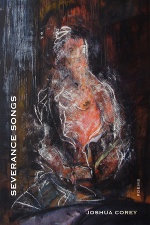Zach Savich: “Turning Through Nature”
 Severance Songs
Severance Songs
Joshua Corey
Tupelo Press, 2011
—
Put anything in fourteen lines, and someone will call it a sonnet; although each poem in Joshua Corey’s third full-length collection, Severance Songs, shares that number of lines (often with visual variations that slide the tree line of the volta up and down the poems’ slopes), his poems are sonnet-like less for their containers than for the bright shapes they contain. The sense of a sonnet, these poems suggest, isn’t in formal configuration but in a manner of speaking, of talking to oneself, of talking things through. In Severance Songs, this manner reels through landscape to render the “pool of newsworthy airs” that “surrounds my perception.”
For Corey, such perception typically comes from pastoral inspiration that he is both suspicious of (“Building sorrows / on a plan of pastoral affection”) and beholden to (“I do not reject terrain”). Early in the collection, a poem begins with a walk; throughout Severance Songs, one sees the record of a mind sent outside by some fever, and what it sees, “ground by the sun’s pestle,” but not what sparked its turn toward the world:
Givens of my walk round: five goslings and two geese
under architecture.
A sapling spines out of rainwater
with a marsh bird in its beak.
The deft sonic—and thematic—echo between “geese” and “beak” embeds a sonnet-like rhyme into lines that, like the work in Shane McCrae’s gorgeous recent book, Mule, visually disrupt the form. But it’s the second image that signals sonnet to me; in my favorite moments in Severance Songs, Corey does with images what Shakespeare does with rhetoric, making complex figures snap precisely to, but through a thickness that preserves their complexity. After the hic-cup of “spines”—one blinks, then hears it as a verb, kept awake for the coming image—one wrongly sees the beak as belonging to the bird, and then, no, the beak is a metaphor for the tree, which has acquired a beak it holds its marsh bird in.
Sound like hard work to decipher? Well, it happens as fast as sight, easy as a tree you notice because it looks like it could take flight. Consider this brilliantly quick depiction of lightning: “Now the dog’s skeleton of an electrical storm / splays itself on our town.” Or this lovely moment, in which the final three words open up the simple image: “A woman thrusts her hands through her window to be clean.” As in Stevens’ line “The bird’s fire-fangled feathers dangle down,” Corey’s images often take much longer to say than they do to see; this lets the sight one arrives at seem both exact and rich with the fizz of perception, with the process of coming into focus that makes the images meaningful.
Elsewhere in Severance Songs, perceptions stream more than they snap, resembling an impressionistic “tension of flight, face forward, borne aloft:”
Skin
windswept, snow of you underhand, muscular
texture melting like the grass over a grave
time-lapsed and filmed in radical reverse
Or, images can begin in precision and then dissolve, as one staring hard at something can fall into thought or lose interest: “saw the starkness // of two roads tunneling into / similar distinctions”; “rinsed chapped hands / cupped skinned water / ice splashing / absence.”
These modes of depiction meet in the poems’ subjects, what the poems use a sonnet’s mindset to think about. There are riffs on war (“This poem does not spill a drop of the fluids that are yours”) and torture (“Like green corn / the nude is hooded, its genitals recognized / by experts”); on classical figures (“The music man wears a high hat”; “The emperor plows the fields”; “Then Corydon put down his flute”); and on our relationship to the natural world (“The bloom is off again, / on again the oil wells”; “Artifacts lodge under / any old soil”). These subjects crop up obliquely, as they might during the course of a walk, and often don’t conclude but veer into closing observations: “The rivers break, the rag ladder has started / up toward a twilight”; “Two crows glanced and fell in imitation of these leaves.” In fact, Corey’s poems can seem all veering, as one walking boldly on ice, in any direction he must. Try to keep speaking as your next step slides another way. Try to have your voice hold us still. Try to see how that voice is yet again, yet differently, making a variation on the proportions of a sonnet.
The language of this veering is churningly stylized, teeming, burling ahead with veiny syntax and wordplay that can both expand and obstruct simple sense; Corey nods to the “deliberate errancy” of this density. This language makes speech as empirical as the many landscapes Corey speaks through, and because it’s default mode is so loud, giving figures like the “asphalt shimmer of august solitudes,” quieter moments become startling. Late in the collection, for example, Corey announces, with affecting simplicity, that “sunlight falls / into my chest, bit of heart that carries me.” And here is a high-voltage passage that charges into a nuanced assertion that, in its performance of revision, of a turning thought, shows the mix of certainty and ambivalence that sonnets have often given:
Hellish complacencies seamed by lightning
cut through the blinds across these blind bodies
knotted to one another’s possibilities. I’m
mining the hour for what’s mine, what’s ours.
—
 Zach Savich is the author of three collections of poetry, including The Firestorm (Cleveland State University Poetry Center, 2011), and a book of ardent prose, Events Film Cannot Withstand (Rescue+Press, 2011). He serves as Book Review Editor with the Kenyon Review. His writing has recently appeared in journals including GulfCoast, A Public Space, and Oh No.
Zach Savich is the author of three collections of poetry, including The Firestorm (Cleveland State University Poetry Center, 2011), and a book of ardent prose, Events Film Cannot Withstand (Rescue+Press, 2011). He serves as Book Review Editor with the Kenyon Review. His writing has recently appeared in journals including GulfCoast, A Public Space, and Oh No.
